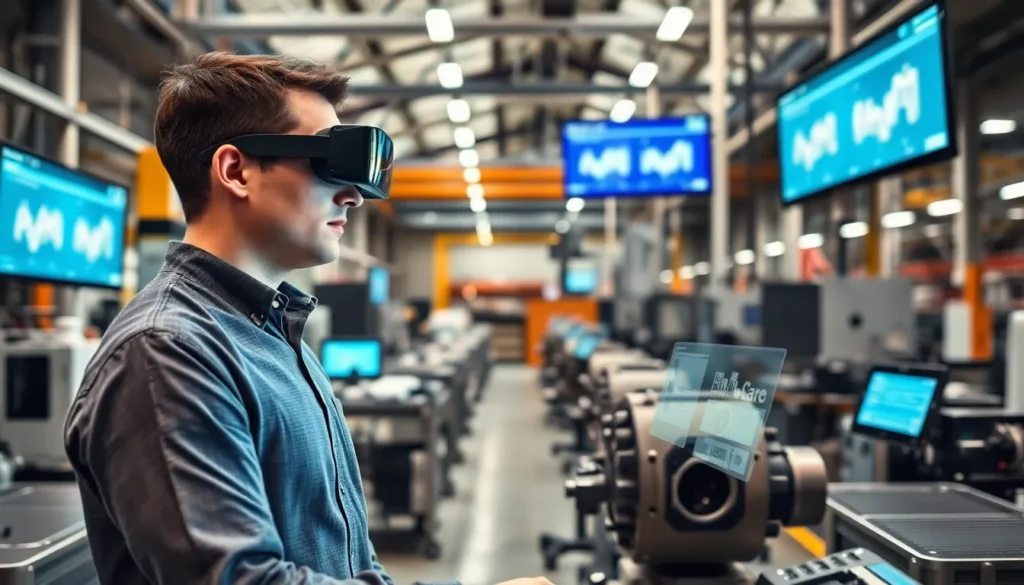In a world where reality often feels a bit too mundane, Augmented Reality Software Development Kits (AR SDKs) are here to spice things up. Imagine transforming your living room into a dinosaur park or your office into a bustling coffee shop in Paris—all with a flick of a finger. AR SDKs are the magic wands that make these whimsical ideas a reality, allowing developers to create immersive experiences that captivate users and keep them coming back for more.
Table of Contents
ToggleOverview of AR SDKs
AR SDKs serve as essential tools for developers in the realm of augmented reality. These kits provide a framework that simplifies the integration of virtual elements into real-world settings. Various platforms offer AR SDKs, enabling compatibility with different devices and operating systems.
Unity’s AR Foundation, for instance, allows creators to build AR experiences that run on both iOS and Android. Vuforia stands out for its robust image recognition capabilities, making it suitable for product visualization applications. Similarly, Apple’s ARKit and Google’s ARCore offer optimized solutions tailored specifically for mobile experiences.
Features of AR SDKs vary significantly. Some prioritize rapid development cycles, while others focus on advanced tracking and environmental understanding. The ease of use often attracts developers new to AR technology. Additionally, community support and documentation play crucial roles in the adoption of these tools.
Performance remains a critical factor in AR experiences. SDKs with efficient rendering techniques ensure that virtual objects stay aligned with the user’s environment in real-time. Tools that include analytics allow developers to gain insights into user engagement, aiding in future improvements.
Integrating AR SDKs into existing applications can enhance user interaction. For example, an educational app might utilize AR to overlay historical information on physical landmarks. This approach not only captivates users but also provides informative content that enriches their experiences.
AR SDKs continue to evolve rapidly, presenting opportunities for developers across various industries. Adopting these tools can lead to innovative applications that transform user perception and interaction with their surroundings.
Popular AR SDKs

Numerous AR SDKs enable developers to create immersive experiences. Below are some of the most popular options available today.
ARKit
ARKit, developed by Apple, focuses on enhancing AR experiences on iOS devices. Users appreciate its advanced environmental understanding and motion tracking capabilities. Technologies like face tracking and image detection enable unique interactions. Apple designed ARKit to leverage the hardware of iPhones and iPads, ensuring smooth performance and rich experiences. Developers create applications that integrate seamlessly into the Apple ecosystem.
ARCore
ARCore stands out as Google’s AR development platform for Android devices. It offers features like motion tracking, environmental understanding, and light estimation. This SDK supports both advanced graphics and user interaction, boosting the engagement level in applications. Developers access tools and APIs that simplify creating realistic AR experiences across a wide range of Android devices. ARCore’s compatibility with various devices enhances its appeal for developers.
Vuforia
Vuforia serves as a versatile AR SDK known for its strong image recognition capabilities. It supports both mobile and smart glasses applications, making it adaptable for different use cases. Developers benefit from robust tracking options, including model targets and cylinder targets, which enhance the usability of applications. Vuforia’s extensive documentation and community support also contribute to its popularity among developers creating AR solutions.
Key Features of AR SDKs
AR SDKs possess several key features that enhance augmented reality experiences. These features include image recognition and 3D object tracking, each offering unique capabilities.
Image Recognition
Image recognition enables AR applications to identify and interact with real-world images and objects. This functionality supports various use cases, such as scanning QR codes or detecting specific landmarks. Many AR SDKs, like Vuforia, provide robust image recognition capabilities, ensuring accurate detection even in challenging conditions. This technology allows developers to overlay digital information onto physical items, enhancing user interaction in environments like museums or retail settings. Developers appreciate image recognition for its potential to create engaging experiences that blend the virtual and real worlds seamlessly.
3D Object Tracking
3D object tracking focuses on monitoring the position and orientation of physical objects in real-time. This capability is crucial for applications that require precise spatial awareness. AR SDKs like ARKit and ARCore utilize advanced algorithms to provide accurate tracking, even as users move around objects. A strong emphasis on performance ensures that virtual elements align correctly with real-world objects, enhancing immersion for users. As a result, developers can create applications that allow users to manipulate and interact with digital content confidently, making experiences in gaming and simulation more immersive.
Use Cases for AR SDKs
AR SDKs drive innovation across multiple sectors, enhancing experiences and engagement. Different industries leverage these tools to deliver unique, interactive applications.
Gaming
Gaming stands out as one of the most popular use cases for AR SDKs. Developers create immersive gameplay experiences by integrating virtual elements into real-world environments. Titles like Pokémon GO exemplify how AR SDKs can blend digital creatures with actual locations, encouraging players to explore. Features such as location tracking enhance user engagement and foster social interactions, transforming gaming into a communal activity. User-generated content becomes possible, allowing players to create and share unique gaming experiences within their surroundings.
Education
In education, AR SDKs revolutionize learning by providing interactive experiences. Learners can visualize complex subjects, such as anatomy or astronomy, through 3D models superimposed on their surroundings. Educational institutions adopt AR SDKs to create engaging lessons that facilitate understanding and retention. Teachers use applications that overlay information on physical objects, enriching field trips or museum visits. Such immersive learning environments captivate students and encourage exploration, making education more accessible and enjoyable.
Retail
Retailers harness AR SDKs to enhance the shopping experience. Customers can visualize products in their homes before making a purchase, bridging the gap between online shopping and real-world interaction. Virtual fitting rooms allow users to try on clothes or accessories using AR technology, minimizing the need for returns. Brands implement AR features in their mobile applications, providing personalized experiences that engage customers and foster brand loyalty. Such innovations drive greater sales and improve overall customer satisfaction.
AR SDKs are revolutionizing how developers approach immersive experiences. Their ability to seamlessly blend virtual elements with the real world opens up endless possibilities for innovation across various industries. As technology continues to advance, these tools will likely become even more sophisticated, enhancing user engagement and interaction.
The versatility of AR SDKs ensures they can cater to diverse needs, whether in gaming, education, or retail. By embracing these powerful frameworks, developers can create captivating applications that not only entertain but also educate and inform. The future of augmented reality looks promising, with AR SDKs at the forefront of this exciting transformation.





